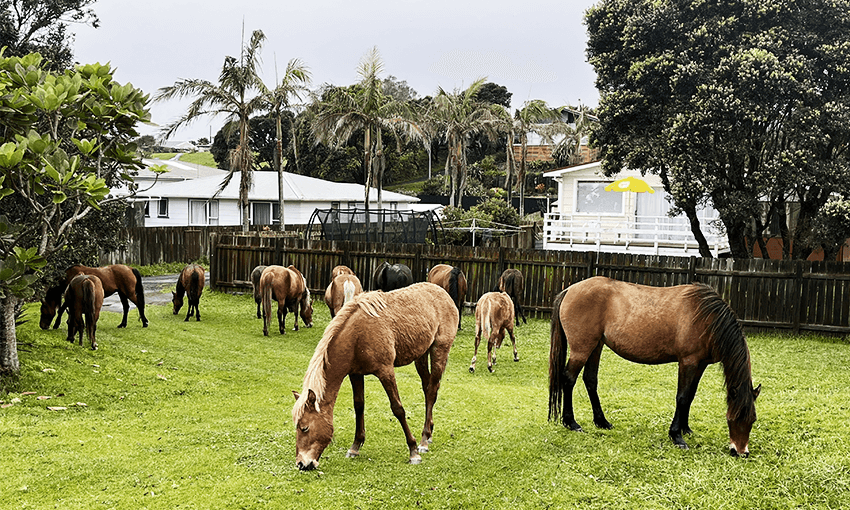Summer reissue: Ahipara has recently been descended on by a band of wild horses, resulting in striking scenes, budding relationships, and heaps and heaps of horse shit.
First published on September 12, 2023.
If you’ve been feeling the lure of 90 Mile Beach after the gorgeous shots in the TV drama Far North, here’s another reason to pine for the small town of Ahipara: a majestic band of 12-15 wild horses has taken over the seaside town.
The horses have descended on the backyard of 73-year-old retired woodturner Steve Collier, an Ahipara homeowner since 1996, and also my dad. In early July, he started sending me photos of the equine visitors grazing in his backyard and around town, with captions like “Got some new friends now”, “Look at this!”, and “How the Far North Council saves money mowing berms.”
Wild horses have lived in the Far North District for “donkey’s years,” Dad tells me over the phone: he first spotted a bunch 27 years ago when he was four-wheel driving up Te Oneroa-a-Tōhe, “way up the other end of 90 Mile Beach, in Te Aupōuri forest.”
Dan, a local taxi driver and trove of Far North knowledge, confirms wild horses have been in the region “basically forever,” and says there are two distinct herds: the Aupōuri herd, which Dad saw in the 90s, and the Twaddell herd, which congregates around the reef at Tauroa, southwest of Ahipara. The band that now hangs around Ahipara is from the latter herd: Dan thinks they probably broke off due to a natural process whereby stallions are kicked out as the herd grows, then steal mares and form a new band.
Strong disrespecters of private property rights, Dad tells me the horses roam freely from the beach onto his yard. After they’re done munching his lawn, they make their way up his driveway and continue chewing at the playground reserve nearby. Selena, who runs Ahipara Horse Treks, says the horses go “anywhere and everywhere” they feel like: into backyards, parks, paddocks – she’s even seen them wandering through the main drag, past Ahipara Superette and Bidz takeaways.
The Far North’s wild horses have been the subject of serious controversy in years past. In the late 1990s, Department of Conservation staff shot and killed seven Aupōuri horses they said damaged a $100,000 electric fence surrounding conservation land, infuriating members of the local iwi, Ngāti Kurī. “One of the mares killed, known as Big Red, had been a favourite of children at Te Hapua School and some pupils had learned to ride on her,” the Herald reported. (Ngāti Kurī trust did not respond to a request for an interview for this story.)
These days, the controversy continues, albeit on a smaller, more low-key scale. Selena describes the local attitude to the horses as “very mixed”. “Some people love them and class them as locals,” she says. “The other half hate them: they’re ruining their lawns and they’re in the way of traffic, that sort of thing.” Dan confirms he’s heard complaints about “horses going wherever they want, walking over everyone’s sections, crapping everywhere and making a mess.”
But Dad, Selena and Dan are all pro-horse, as are most of the longstanding locals, Dan says. Some are even making the most of all the horseshit. “I know of one old fullah who walks around with a wheelbarrow and he loves it,” Dan tells me, “because he picks it all up and takes it back to his garden.”
Dan grew up in Ahipara, and horses are an integral part of the town’s history, he says. “We all grew up with horses. Everyone had their own horse tied up on their section. There weren’t many cars and motorbikes and stuff like that, so everyone went around on horseback. If I had my way, I’d be on horses 100% of the time.”
Despite them staging a ruthless takeover of his property, Dad sometimes feels moved by the horses’ humble way of life. “Yesterday I looked out of the window, and there they all were,” he said, switching into an oratory mode. “The heavens darkened and the rains poured down and they were all standing there, all facing the same way, looking out to sea. And I felt a bit sorry for them, you know. But that’s how they live their lives.”
Soggy as they may sometimes get, overall the horses’ lives seem far from pitiable: they’re gorgeous, hardy creatures, with an untrammeled run on the bountiful Ahipara grasses. The relationship is symbiotic, too: the wild horses get to graze in a picturesque seaside town, and the human residents are treated to sublime equine scenes. “They’re getting quite used to humans,” Selena says. “The kids will go up and pat them at the park.”
Messy, arrogant and rebellious as they might be, horses like these are “iconic to Ahipara”, Dan says. My dad’s lifelong friend Blue, another recipient of the horse pics, sums up the situation well: “Man,” he says, “does that beach keep on giving.”



